Cell Division
Cell division begins with Interphase. It's about 1/3 of the time required for cell division. It contains the G1, S, and G2 phases. Some nerve cells have a Go phase. Chromosomes are duplicated.
Somatic cell division is cytoplasmic division [cytokinesis] and nuclear division [mitosis]. The stages of mitosis are prophase, metaphase, anaphase, and telophase. Interphase occurs between cell divisions and is when organelles and DNA are duplicated.
During prophase, the threats off chromatin become tightly coiled and condense into chromasomes, the little X's that contain all coiled up DNA. A chromosome is made of two strands, or chromatids, and are held at the center by a round centromere. A protein structure called a kinetochore surrounds the centromere and the chromatid spindles bond to it.
Centrioles are those rodlike bundles that go around the nucleus to divide it eventually. They have microtubules to help accomplish this, called asters. The nuclear membranes disperse into the cytoplasm and the nucleoli break down and disappear.
In metaphase, the nuclear membrane has broken down and the spindle fibers have moved into the nuclear area. The chromosomes line up along the plane midway between the poles, forming the metaphase, or equatorial, plane. Two chromatids of each chromosome seperate. Formation of the metaphase plane and duplication of the centromeres completes metaphase.
In anaphase, the shortest of the mitotic phases, the centromeres divide so that each chromatid has its own. Anaphase is characterized by the migration of the chromatids. The two chromatids of each chromosome move toward opposing poles, with the centromeres leading the way. The contractile proteins of the spindles are responsible for pulling the chromatids toward each centriole.
In telophase the chromosomes uncoil and return to DNA strands in the 2 new nuclear membranes. Spindle fibers disappear into the cytoplasm nucleoli reappear in the nuclei. the cytoplasm divides [cytokinesis] with its organells, and two identical cells with identical DNA are left.
Somatic cell division is cytoplasmic division [cytokinesis] and nuclear division [mitosis]. The stages of mitosis are prophase, metaphase, anaphase, and telophase. Interphase occurs between cell divisions and is when organelles and DNA are duplicated.
During prophase, the threats off chromatin become tightly coiled and condense into chromasomes, the little X's that contain all coiled up DNA. A chromosome is made of two strands, or chromatids, and are held at the center by a round centromere. A protein structure called a kinetochore surrounds the centromere and the chromatid spindles bond to it.
Centrioles are those rodlike bundles that go around the nucleus to divide it eventually. They have microtubules to help accomplish this, called asters. The nuclear membranes disperse into the cytoplasm and the nucleoli break down and disappear.
In metaphase, the nuclear membrane has broken down and the spindle fibers have moved into the nuclear area. The chromosomes line up along the plane midway between the poles, forming the metaphase, or equatorial, plane. Two chromatids of each chromosome seperate. Formation of the metaphase plane and duplication of the centromeres completes metaphase.
In anaphase, the shortest of the mitotic phases, the centromeres divide so that each chromatid has its own. Anaphase is characterized by the migration of the chromatids. The two chromatids of each chromosome move toward opposing poles, with the centromeres leading the way. The contractile proteins of the spindles are responsible for pulling the chromatids toward each centriole.
In telophase the chromosomes uncoil and return to DNA strands in the 2 new nuclear membranes. Spindle fibers disappear into the cytoplasm nucleoli reappear in the nuclei. the cytoplasm divides [cytokinesis] with its organells, and two identical cells with identical DNA are left.

